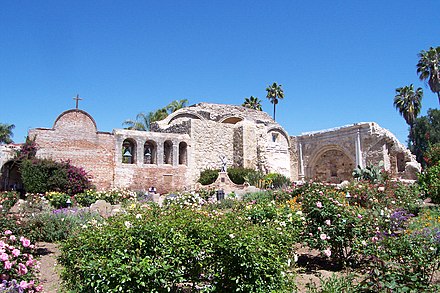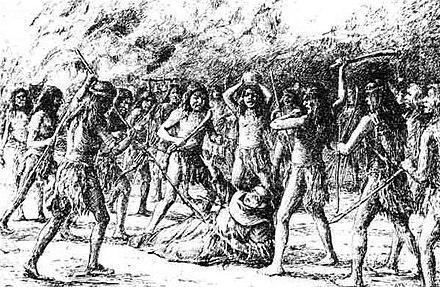

The Spanish missions in California (Spanish: Misiones españolas en California) formed a series of 21 religious outposts or missions established between 1769 and 1833 in what is now the U.S. state of California. The missions were established by Catholic priests of the Franciscan order to evangelize indigenous peoples backed by the military force of the Spanish Empire. The missions were part of the expansion and settlement of New Spain through the formation of Alta California, expanding the empire into the most northern and western parts of Spanish North America. Civilian settlers and soldiers accompanied missionaries and formed settlements like the Pueblo de Los Ángeles.[2]
Indigenous peoples were forced into settlements called reductions,[3] disrupting their traditional way of life and negatively affecting as many as one thousand villages.[2] European diseases spread in the close quarters of the missions, causing mass death.[4] Abuse, malnourishment, and overworking were common.[5] At least 87,787 baptisms and 63,789 deaths occurred.[6] Indigenous peoples often resisted and rejected conversion to Christianity.[7] Some fled the missions while others formed rebellions.[7] Missionaries recorded frustrations with getting indigenous people to internalize Catholic scripture and practice.[7] Indigenous girls were taken away from their parents and housed at monjeríos.[8] The missions' role in destroying Indigenous culture has been described as cultural genocide.[5]
By 1810, Spain's king had been imprisoned by the French, and financing for military payroll and missions in California ceased.[9] In 1821, Mexico achieved independence from Spain, yet did not send a governor to California until 1824. The missions maintained authority over indigenous peoples and land holdings until the 1830s. At the peak of their influence in 1832, the coastal mission system controlled approximately one-sixth of Alta California.[10] The First Mexican Republic secularized the missions with the Mexican secularization act of 1833, which emancipated indigenous peoples from the missions. Mission lands were largely given to settlers and soldiers, along with a minority of indigenous people.[7]
The surviving mission buildings are the state of California's oldest structures and most-visited historic monuments, many of which were restored after falling into near disrepair in the early 20th century. They have become a symbol of California, appearing in many movies and television shows, and are an inspiration for Mission Revival architecture. Concerns have been raised by historians and Indigenous peoples of California about the way the mission period in California is taught in educational institutions and memorialized.[8] The oldest European settlements of California were formed around or near Spanish missions, including the four largest: Los Angeles, San Diego, San Jose, and San Francisco. Santa Barbara, and Santa Cruz were also formed near missions, and the historical imprint reached as far north as Sonoma in what became the wine country.
Prior to 1754, grants of mission lands were made directly by the Spanish Crown. But, given the remote locations and the inherent difficulties in communicating with the territorial governments, he delegated authority to make grants to the viceroys of New Spain.[11] During the reign of King Charles III, they granted lands to allow establishing the Alta California missions. They were motivated in part by presence of Russian fur traders along the California coast in the mid 1700s.[12]
The missions were to be interconnected by an overland route which later became known as the Camino Real. The detailed planning and direction of the missions was to be carried out by Friar Junípero Serra, O.F.M. (who, in 1767, along with his fellow priests, had taken control over a group of missions in Baja California Peninsula previously administered by the Jesuits). After Serra's death, Rev. Fermín Francisco de Lasuén established nine more mission sites, from 1786 through 1798; others established the last three compounds, along with at least five asistencias (mission assistance outposts).[13]
Work on the coastal mission chain was concluded in 1823, completed after Serra's death in 1784. Plans to build a twenty-second mission in Santa Rosa in 1827 were canceled.[notes 1][citation needed]
The Rev. Pedro Estévan Tápis proposed establishing a mission on one of the Channel Islands in the Pacific Ocean off San Pedro Harbor in 1784, with either Santa Catalina or Santa Cruz (known as Limú to the Tongva residents) being the most likely locations, the reasoning being that an offshore mission might have attracted potential people to convert who were not living on the mainland, and could have been an effective measure to restrict smuggling operations.[14] Governor José Joaquín de Arrillaga approved the plan the following year; however, an outbreak of sarampión (measles) killing some 200 Tongva people coupled with a scarcity of land for agriculture and potable water left the success of such a venture in doubt, so no effort to found an island mission was ever made.[citation needed]
In September 1821, the Rev. Mariano Payeras, "Comisario Prefecto" of the California missions, visited Cañada de Santa Ysabel east of Mission San Diego de Alcalá as part of a plan to establish an entire chain of inland missions. The Santa Ysabel Asistencia had been founded in 1818 as a "mother" mission. However, the plan's expansion never came to fruition.[citation needed]


In addition to the presidio (royal fort) and pueblo (town), the misión was one of the three major agencies employed by the Spanish sovereign to extend its borders and consolidate its colonial territories. Asistencias ("satellite" or "sub" missions, sometimes referred to as "contributing chapels") were small-scale missions that regularly conducted Mass on days of obligation but lacked a resident priest;[16] as with the missions, these settlements were typically established in areas with high concentrations of potential native converts.[17] The Spanish Californians had never strayed from the coast when establishing their settlements; Mission Nuestra Señora de la Soledad was located farthest inland, being only some thirty miles (48 kilometers) from the shore.[18] Each frontier station was forced to be self-supporting, as existing means of supply were inadequate to maintain a colony of any size. California was months away from the nearest base in colonized Mexico, and the cargo ships of the day were too small to carry more than a few months' rations in their holds. To sustain a mission, the padres required converted Native Americans, called neophytes, to cultivate crops and tend livestock in the volume needed to support a fair-sized establishment. The scarcity of imported materials, together with a lack of skilled laborers, compelled the missionaries to employ simple building materials and methods in the construction of mission structures.

Although the missions were considered temporary ventures by the Spanish hierarchy, the development of an individual settlement was not simply a matter of "priestly whim." The founding of a mission followed longstanding rules and procedures; the paperwork involved required months, sometimes years of correspondence, and demanded the attention of virtually every level of the bureaucracy. Once empowered to erect a mission in a given area, the men assigned to it chose a specific site that featured a good water supply, plenty of wood for fires and building materials, and ample fields for grazing herds and raising crops. The padres blessed the site, and with the aid of their military escort fashioned temporary shelters out of tree limbs or driven stakes, roofed with thatch or reeds (cañas). It was these simple huts that ultimately gave way to the stone and adobe buildings that exist to the present.
The first priority when beginning a settlement was the location and construction of the church (iglesia). The majority of mission sanctuaries were oriented on a roughly east–west axis to take the best advantage of the sun's position for interior illumination; the exact alignment depended on the geographic features of the particular site. Once the spot for the church had been selected, its position was marked and the remainder of the mission complex was laid out. The workshops, kitchens, living quarters, storerooms, and other ancillary chambers were usually grouped in the form of a quadrangle, inside which religious celebrations and other festive events often took place. The cuadrángulo was rarely a perfect square because the missionaries had no surveying instruments at their disposal and simply measured off all dimensions by foot. Some fanciful accounts regarding the construction of the missions claimed that tunnels were incorporated in the design, to be used as a means of emergency egress in the event of attack; however, no historical evidence (written or physical) has ever been uncovered to support these assertions.[19][notes 2]

The Alta California missions, known as reductions (reducciones) or congregations (congregaciones), were settlements founded by the Spanish colonizers of the New World with the purpose of totally assimilating indigenous populations into European culture and the Catholic religion. It was a doctrine established in 1531, which based the Spanish state's right over the land and persons of the Indies on the Papal charge to evangelize them. It was employed wherever the indigenous populations were not already concentrated in native pueblos. Indians were congregated around the mission proper through forced resettlement, in which the Spanish "reduced" them from what they perceived to be a free "undisciplined'" state with the ambition of converting them into "civilized" members of colonial society.[24] The civilized and disciplined culture of the natives, developed over 8,000 years, was not considered. A total of 146 Friars Minor, mostly Spaniards by birth, were ordained as priests and served in California between 1769 and 1845. Sixty-seven missionaries died at their posts (two as martyrs: Padres Luis Jayme and Andrés Quintana), while the remainder returned to Europe due to illness, or upon completing their ten-year service commitment.[25] As the rules of the Franciscan Order forbade friars to live alone, two missionaries were assigned to each settlement, sequestered in the mission's convento.[26] To these the governor assigned a guard of five or six soldiers under the command of a corporal, who generally acted as steward of the mission's temporal affairs, subject to the priests' direction.[27]
Indians were initially attracted into the mission compounds by gifts of food, colored beads, bits of bright cloth, and trinkets. Once a Native American "gentile" was baptized, they were labeled a neophyte, or new believer. This happened only after a brief period during which the initiates were instructed in the most basic aspects of the Catholic faith. But, while many natives were lured to join the missions out of curiosity and sincere desire to participate and engage in trade, many found themselves trapped once they were baptized.